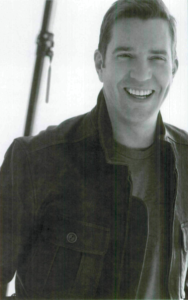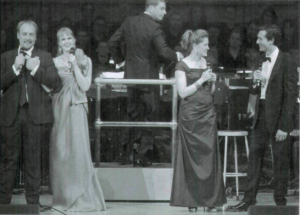Sitting in his sleek, stylish apartment high above New York City’s Midtown West, Steven Reineke is on top of the world. The handsome and enterprising music director of the New York Pops Orchestra is just a heartbeat away from the proscenium stages that have defined the American musical theater. But he’s also a short walk from Carnegie Hall, good for the cardiovascular workout a conductor needs to keep fit. Broadway and the concert hall intersect in Reineke’s world, and on Nov. 19, 2010, this intersection was on display, much to the delight of the Carnegie Hall audience, in a celebration of the 80th birthday of Stephen Sondheim, who must be somewhere in the Guinness Book of Records for tributes.

The program was an energetic and exciting program of familiar works given a popular spin, done with the adulation and enthusiasm of a pep rally. Carnegie Hall’s Perelman stage was filled to the gills with the New York Pops Orchestra, the largest independent group of its kind in the United States, and the 80-person (one for each year of Sondheim’s life) Essential Voices, USA, under the direction of Judith Clurman, as well as four gifted Broadway actors – Kate Baldwin, Alexander Gemignani, Aaron Lazar and Christiane Noll – and one cabaret legend, Marilyn Maye.
Reineke, in his second year with the orchestra, marries the sensibility of the show tune with the large orchestral sounds usually associated with symphonic compositions. Accordingly, this was not a concert of Sondheim obscuriana, but one organized thematically around the rich and vibrant character-driven songs that define the Sondheim catalog.
“I’d seen a lot of other people’s galas and benefits,” Reineke says, “and that was to do a lot of the great hits. Being in New York City, I felt like a lot of people either made it a star-studded gala where it overshadowed the songs, or else the material was very heady.” His goal was to appease the sold-out audience and give them exactly what they expected – big, bold and brassy – yielding a result that affirms the versatility of the Sondheim score. If the nuanced, introspective and brainy aspects of Sondheim’s work were layered beneath the surface, they often came brilliantly to light, as in a wonderful rendition of “A Weekend in the Country,” with Clurman’s disciplined ensemble adding their voices at one of the delicious modulations.
“Sondheim is both a renaissance composer and an American composer,” Clurman points out. “You see and hear the classical forms but he also uses a synagogue mode over and over,” referring to a Yiddish folk music form. In the world of musical theatre, of course, Jewish equals American. She even calls Sondheim an “American Mozart.” Like Mozart, he’s writing everything you need in the score. “You don’t have to ungapatchke a Sondheim song,” she adds, using the Yiddish term for “overly decorated.” “There’s an honest simplicity in the music.”
Clurman’s Essential Voices USA is well into a three-year residency with the New York Pops, and Reineke and Clurman are part of a mutual admiration society. They worked fiercely together to bring a multitude of voices to a program incorporating arrangements from Jonathan Tunick, Jason Robert Brown and even the BBC Proms concerts. The poignant anthem “Children Will Listen,” which makes Clurman teary, was given a lush, glorious treatment by Reineke using his symphonic resources, which included 42 string players. “When a chorus does it right,” Clurman says, “and they’re singing Sondheim and not Bach and every color is different, I don’t need to conduct them. For me it’s words, words, words. I don’t care if they sing an eighth-note wrong. I want the communication.”

The radiant Baldwin, a Little Red Ridinghood who has graduated to Cinderella, was scared and excited to be singing on the program. Even though concert work is very stressful, she says there’s also an excitement that’s palpable and sustaining artistically. And the juxtaposition of clever lyrics, emotional music and the seemingly detached nature of a Sondheim character on a concert stage is an artistic challenge, whether one is a soloist or a chorister.
Clurman is adamant that Sondheim is not a choral composer, and she is not conducting a chorus but an “ensemble.” In rehearsal she works tirelessly to get a sound that does not undermine the composer/lyricist. “What separates the men from the boys is the pickups to the downbeats,” she admonishes as if she were coaching actors, not singers. “Don’t collapse the sound. Don’t manufacture the crescendo – just let it happen.”
Perhaps this is the single most important idea in the singing of this particular music. A Sondheim song is born from a specific moment for a specific character, so it’s natural that Clurman would want to squeeze out every drop of truthfulness in performance. She’s a whirling dervish in the rehearsal room, and her energy is matched by Reineke’s pizzazz. There’s a reassuring sense of the purist in both of them. He waxes eloquent on the subliminal use of effective dynamic markings in preparing an orchestral score. She obsesses over diction. Both of them have pedigrees that have prepared them for such a partnership.
For Reineke, Sondheim is inspirational. Like Georges Scurat in Sunday in the Park with George, Sondheim has the ability to “create something out of nothing,” a talent that has informed much of his work over the past 20 years. Reineke references his seminal work with his mentor, the great Cincinnati Pops maestro Erich Kunzel, and connects this relationship with Sondheim and Oscar Hammerstein II. Pointing to an affectionate photograph on the piano of the two of them looking like father and son, he told me he moved from Cincinnati to New York City exactly one year after Kunzel’s death.
Similarly, there is a profound sense of honor that carries through when he talks about his collaboration with Sondheim on some of the selections and arrangements for the tribute concert. “I agonized over every e-mail exchange, thinking: Am I sounding witty enough? Is my grammar right? My spelling right? Do I sound intelligent?” In reality, he has been connected inexorably to Sondheim since his college days at Miami University in Ohio.
“Probably my stand-alone favorite Sondheim tune is ‘Move On,'” he says. “A friend of mine knew I loved the words so much he had the lyrics framed, and I hung it in my dorm room throughout college,” Not surprisingly, the powerfully inspiring song from Sunday in the Park with George, one of the two prominent 11 o’clock numbers (the other, “I’m Still Here,” made to measure for Marilyn Maye), was richly sung at the concert by Lazar and Noll. He adds that organizing a concert such as this is an overwhelming task but quotes the lyric, “the choice may have been mistaken, the choosing was not,” to keep things in perspective.
Clurman, an Emmy-nominated conductor and vocal educator who served as director of choral activities at the Julliard School for almost 20 years, has long been yoked to Sondheim, as have her singers, who appeared in the Symphony Space 75th-birthday tribute in 2005. Equally at home with Verdi and Kelli O’Hara, Milton Babbitt and Kermit the Frog, she cut her teeth studying classical piano, while playing those “danged Broadway show LPs” that her mother bought after taking her and her sister to a see a different show every week – either on Broadway or at the Westbury Music Fair.
Sondheim has influenced her work immensely, whether it’s classical music or theatre music. “I don’t think those boundaries should be up at all.” All of her singers must memorize the music or she will not let them sing in the concert. Of course, Sondheim aficionados already know all the lyrics to his songs, but she insists that having the ensemble sing “off-book” raises the stakes. “I always thought that singing Sondheim in a large ensemble setting meant you have to act the song,” she adds, which makes perfect sense.
Insisting that this in not choral music (“Comedy Tonight” and “Getting Married Today” were also arranged for ensemble voices and interpolated into the program), she adds. “When Steven asked me about bringing in a chorus I kvetched and moaned and said no, no, no. The chorus can add a color in unison to this, but he is not a choral composer. Let’s call it an ensemble. I work in a lot of high schools, and it’s great that the kids are learning Sondheim, but they are trying to Glee-ify it. But this in not Sondheim. Even when you think of Sweeney Todd – and I saw the original four times – I don’t like people singing “oohs” and “aahs” in choral arrangements. I take all that stuff out. It needs to be gritty when you sing musical theatre.”
In the end, though, the assimilation of the symphonic and the musical theatre stages rests in a joyful amalgamation in the listener’s ear. Kunzel said to his protégé, “I don’t care if it’s Beethoven or the Beatles, approach it with the same amount of integrity.” Reineke adds, “Good music. I learned it from Erich. He always said it was about the audience and the music.”